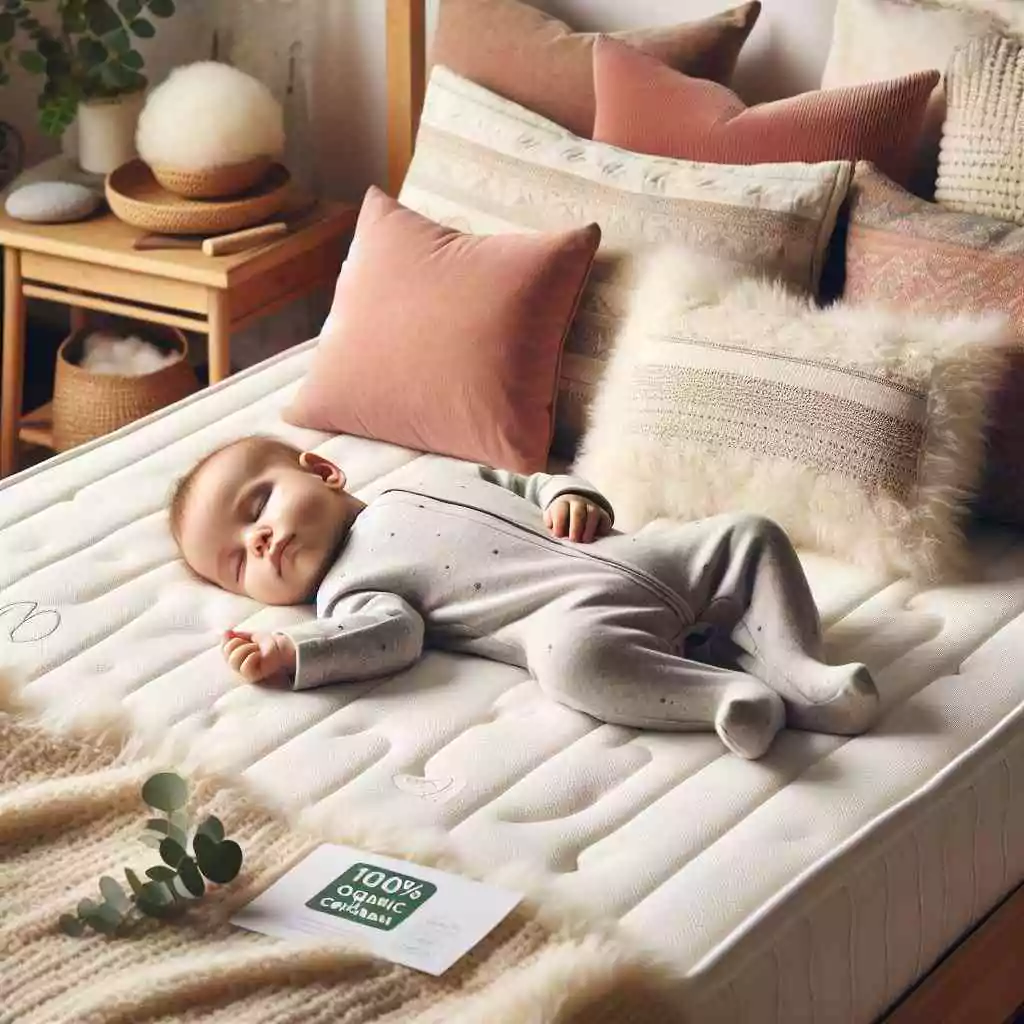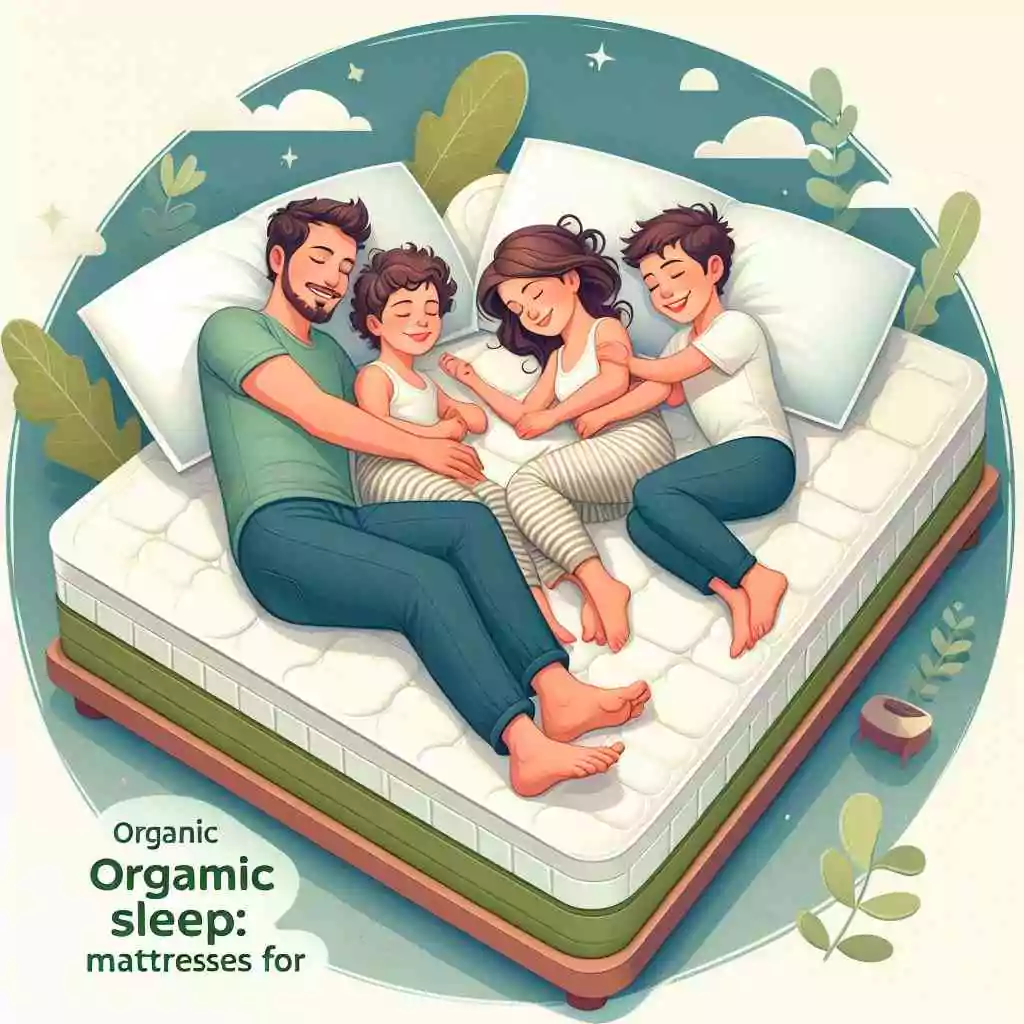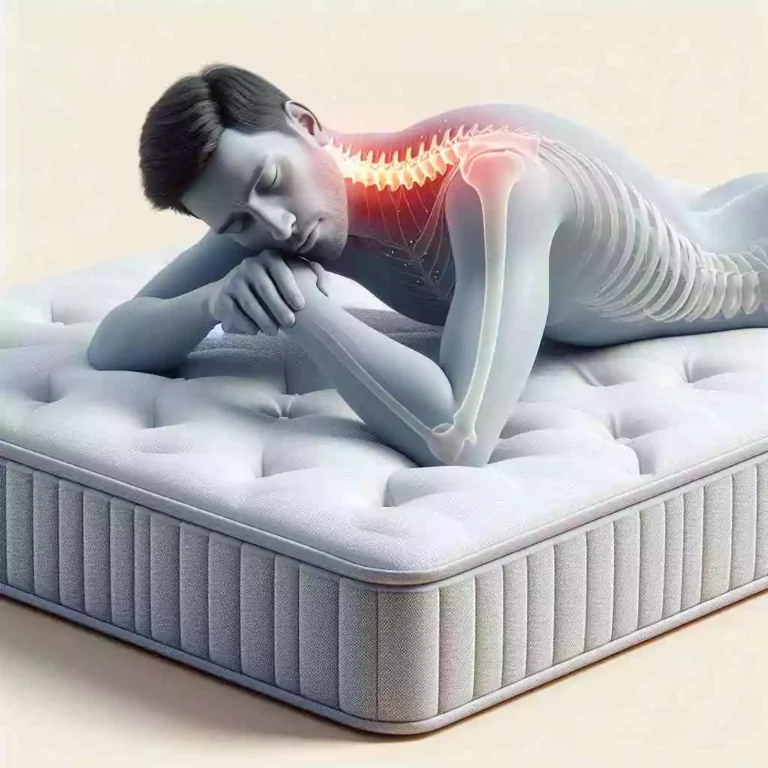Do you love snuggling with your baby at night? Do you enjoy the warmth, closeness, and convenience of sharing a bed with your little one? If you answered yes, then you are not alone. Co-sleeping, or sleeping in the same bed or proximity to your baby, is a common and natural practice that many parents worldwide choose for their babies.
Co-sleeping can benefit parents and babies by improving sleep, reducing stress, enhancing bonding, and promoting health.
However, co-sleeping comes with challenges and risks, especially when choosing the right mattress. You need to ensure that the mattress you use for co-sleeping is safe, comfortable, supportive, and suitable for you and your baby. You also need to consider the mattress’s size, firmness, material, and cover, as well as the safety standards and certifications. Choosing the wrong mattress for co-sleeping can lead to severe problems, such as suffocation, overheating, sleep disruption, and even sudden infant death syndrome (SIDS).
So, how do you choose the best mattress for co-sleeping with your baby? What are the factors to consider when shopping for a co-sleeping mattress? What are the best co-sleeping mattresses available in the market today? In this blog post, we will answer these questions and more. We will explain what co-sleeping is, the benefits and risks, and how to choose the best mattress for co-sleeping with your baby. We will also review the top co-sleeping mattresses in different categories: organic, non-toxic, customized, and crib mattresses. By the end of this blog post, you will have a clear idea of how to find the perfect mattress for your family’s co-sleeping needs.
Table of Contents
Understanding Co-Sleeping
Co-sleeping is sleeping in the same bed or proximity with your baby. Co-sleeping can take different forms, such as:
- Bed-sharing is when parents and babies sleep in the same bed, usually on a large, firm mattress.
- Side-car: This is when a crib or bassinet is attached to the side of the parent’s bed, creating a separate but adjacent sleeping space for the baby.
- Room-sharing: This is when parents and babies sleep in the same room but on different beds or surfaces, such as a crib, a cradle, or a playpen.
Co-sleeping is a common and natural practice in many cultures, where parents and babies sleep in the same bed or proximity for cultural, emotional, or practical reasons. Some of the reasons why parents choose co-sleeping are:

- Bonding: Co-sleeping can facilitate bonding and attachment between parents and babies, as they can cuddle, touch, and communicate more easily and frequently.
- Breastfeeding: Co-sleeping can make breastfeeding more convenient and frequent, as mothers can nurse their babies without getting up or moving to another room.
- Responding: Co-sleeping can make responding to the baby’s needs more quick and effective, as parents can hear, see, and feel their baby’s cues and signals.
- Saving: Co-sleeping can save space and money, as parents do not need to buy or set up separate beds and bedding for their babies.
Co-sleeping can also have several benefits for both parents and babies, such as:
- Improving sleep: Co-sleeping can enhance the quality and duration of sleep for both parents and babies, as they can sync their sleep cycles, regulate their body temperatures, and reduce their stress and anxiety levels.
- Reducing stress: Co-sleeping can reduce the stress and anxiety levels of both parents and babies, as they can feel more secure, relaxed, and comforted by each other’s presence and touch.
- Increasing oxytocin: Co-sleeping can increase the oxytocin levels of both parents and babies. Oxytocin is a hormone that promotes love, trust, and relaxation. It can also stimulate milk production, lower blood pressure, and boost the immune system.
- Lowering depression: Co-sleeping can reduce the risk of postpartum depression and mood disorders for mothers, as they can feel more connected, supported, and satisfied with their parenting role and relationship with their baby.
- Boosting health: Co-sleeping can boost the health and development of babies, as they can benefit from skin-to-skin contact, breast milk, and stimulation from their parents. Co-sleeping can also lower the risk of SIDS, as babies can breathe more easily and avoid overheating.
However, co-sleeping comes with challenges and risks, especially when choosing the right mattress. You need to ensure that the mattress you use for co-sleeping is safe, comfortable, supportive, and suitable for you and your baby. Choosing the wrong mattress for co-sleeping can lead to severe problems, such as:
- Suffocation: Co-sleeping can increase the risk of suffocation for babies, as they can get trapped or covered by the mattress, the bedding, or the parents’ bodies.
- Overheating: Co-sleeping can increase the risk of overheating for babies, as they can get too warm from the mattress, the bedding, or the parents’ body heat.
- SIDS: Co-sleeping can increase the risk of sudden infant death syndrome (SIDS) for babies, which is the unexplained death of a healthy baby during sleep. SIDS can be caused by suffocation, overheating, rebreathing, or other unknown factors.
- Sleep disruption: Co-sleeping can reduce the quality and quantity of sleep for both parents and babies, as they can get disturbed by each other’s movements, noises, or habits.
- Intimacy: Co-sleeping can reduce the intimacy and privacy of the parents, as they have less space and time for themselves and their partner.
- Dependency: Co-sleeping can create dependency and difficulty in transitioning to separate beds, as the baby gets used to sleeping with the parents and may resist sleeping alone.
Therefore, choosing the right mattress for co-sleeping is crucial for your and your baby’s well-being. You need to consider several factors when shopping for a co-sleeping mattress, such as the size, firmness, material, and cover of the mattress, as well as the safety standards and certifications. In the next section, we will discuss these factors in more detail and give tips on choosing the best mattress for co-sleeping with your baby.

Factors to Consider When Choosing a Co-Sleeping Mattress
Choosing the right mattress for co-sleeping is more complex than picking the first one you see or the one that looks the most comfortable. You need to consider several factors that can affect the mattress’s safety, comfort, support, and suitability for you and your baby. Here are some of the most important factors to consider when choosing a co-sleeping mattress:
- Safety: Safety is the most crucial factor to consider when choosing a co-sleeping mattress. It would help if you ensured that the mattress meets the safety standards and certifications of the Consumer Product Safety Commission (CPSC) and the American Academy of Pediatrics (AAP). These standards and certifications ensure the mattress is free of harmful chemicals, flammable materials, and other hazards that can risk your and your baby’s health. You must also ensure the mattress fits snugly in your bed frame, leaving no gaps or spaces where your baby can get trapped or fall. You must also avoid using pillows, blankets, comforters, or other soft bedding that can cover or smother your baby. You must also keep your baby away from the edges, corners, or sides of the bed, where they can roll off or get stuck. You also need to position your baby on their back, not on their stomach or side, to prevent suffocation or SIDS. You also need to avoid smoking, drinking, or taking drugs before or during co-sleeping, as these can impair your judgment, awareness, and reflexes and increase the risk of harming your baby.
- Comfort: The second factor to consider when choosing a co-sleeping mattress is comfort. You need to ensure that the mattress is comfortable for you and your baby, as this can affect the quality and duration of your sleep. You need to look for a breathable, hypoallergenic, and organic mattress, as these can prevent overheating, allergies, and irritation for you and your baby. It would help if you also looked for a mattress that has a removable, washable, and waterproof cover, as this can protect the mattress from stains, spills, and dust mites and keep it clean and fresh. It would help if you also looked for a mattress with a good warranty, return policy, and customer service, as these can ensure you get the best value and satisfaction from your purchase.
- Support: The third factor to consider when choosing a co-sleeping mattress is support. You must ensure that the mattress supports you and your baby, which can affect the alignment and health of your spine, joints, and muscles. You need to look for a mattress that is firm enough to support your baby’s spine and prevent sagging or sinking but not too firm that it causes pressure points or discomfort. It would help if you also looked for a responsive and adaptive mattress, as this can confirm.
- Size and firmness: The fourth factor to consider when choosing a co-sleeping mattress is size and firmness. You must ensure the mattress is big enough to accommodate you and your baby without crowding or falling off. You also need to ensure that the mattress is firm enough to prevent your baby from rolling into you or getting stuck between you and the mattress. You also need to avoid using a mattress that is too soft, as this can cause your baby to sink into the mattress and suffocate. You also need to avoid using a mattress that has a pillow top, a memory foam layer, or a waterbed, as these can also pose a suffocation risk for your baby. You also need to avoid using a mattress that is too old, worn, or saggy, as this can compromise the support and safety of the mattress. You also need to avoid using a mattress that is too new, as this can emit harmful gasses or odors that can irritate your and your baby’s respiratory system.
The best size and firmness for a co-sleeping mattress depend on your preference, bed size, and baby’s age and weight. Generally, a king-size or queen-size mattress is recommended for co-sleeping, as these can provide enough space and comfort for you and your baby. However, if you have a smaller bed or a limited budget, you can also use a full-size or twin-size mattress if you follow the safety precautions and guidelines. As for firmness, a medium-firm to firm mattress is recommended for co-sleeping, as these can provide enough support and stability for both you and your baby. However, if you have a back or joint problem or prefer a softer feel, you can also use a medium-soft to a soft mattress, as long as you use a firm mattress topper or pad to add extra firmness and protection for your baby.
The following section will review the top co-sleeping mattresses in different categories: organic, non-toxic, customized, and crib mattresses. We will compare and contrast each mattress’s features, pros, and cons and give you our honest and unbiased opinion on which is the best for co-sleeping with your baby. Stay tuned!
Review of Top Co-Sleeping Mattresses
Now that you know what factors to consider when choosing a co-sleeping mattress, you might be wondering what the best co-sleeping mattresses available today are. To help you decide, we have reviewed the top co-sleeping mattresses in different categories: organic, non-toxic, customized, and crib mattresses. We have compared and contrasted each mattress’s features, pros, and cons, giving you our honest and unbiased opinion on which one is the best for co-sleeping with your baby. Here are our top picks for the best co-sleeping mattresses:
Organic Co-Sleeping Mattresses
If you are looking for a co-sleeping mattress made of natural, organic, and eco-friendly materials, consider an organic co-sleeping mattress. An organic co-sleeping mattress is a mattress that is made of organic cotton, wool, latex, or other natural fibers that are grown and processed without the use of pesticides, herbicides, synthetic fertilizers, or other harmful chemicals. An organic co-sleeping mattress is also certified by reputable organizations, such as the Global Organic Textile Standard (GOTS), the Global Organic Latex Standard (GOLS), or the Organic Content Standard (OCS), that verify the quality and purity of the organic materials and the ethical and environmental practices of the manufacturers.
An organic co-sleeping mattress can have many benefits for you and your baby, such as:

- Breathability: An organic co-sleeping mattress can provide excellent breathability, as the natural fibers can allow air to circulate freely and regulate the temperature and moisture of the mattress. This can prevent overheating, sweating, and discomfort for you and your baby.
- Hypoallergenic: An organic co-sleeping mattress can be hypoallergenic, as the natural fibers can resist dust mites, mold, mildew, and other allergens that can trigger allergies, asthma, or eczema for you and your baby.
- Durability: An organic co-sleeping mattress can be durable, as the natural fibers retain their shape, elasticity, and resilience long and resist sagging, sinking, or indenting. This can ensure that the mattress provides consistent support and comfort for you and your baby.
- Sustainability: An organic co-sleeping mattress can be sustainable, as the natural fibers are biodegradable, renewable, and recyclable and do not contribute to environmental pollution or degradation. This can reduce your carbon footprint and support the health and well-being of the planet.
However, an organic co-sleeping mattress can also have some drawbacks, such as:
- Cost: An organic co-sleeping mattress can be expensive, as the natural fibers can be scarce, labor-intensive, and costly to produce and process. It can also require more certifications and inspections, which can add to the price of the mattress.
- Availability: An organic co-sleeping mattress can be hard to find, as the natural fibers are limited in supply and demand and not widely distributed or marketed. An organic co-sleeping mattress can also have less variety and customization options, as the natural fibers can have fewer colors, textures, and designs to choose from.
- Maintenance: An organic co-sleeping mattress can require more maintenance, as the natural fibers can be more sensitive and prone to stains, spills, and odors. An organic co-sleeping mattress can also need more care and protection, such as regular airing, sunning, and vacuuming, and using a mattress protector, pad, or cover.
Here are some of the best organic co-sleeping mattresses that we have reviewed:
- Soaring Heart Natural Bedding Organic Latex Mattress: This is a co-sleeping mattress made of organic latex, wool, and cotton. The organic latex provides a firm, supportive, and responsive base, while the organic wool adds a soft, cozy, and breathable layer. The organic cotton covers the mattress with a smooth, plush, and luxurious fabric. The mattress is certified by GOTS, GOLS, and OCS and is handmade in the USA. The mattress comes in different sizes, from twin to king, with a 20-year warranty and a 30-day return policy. The mattress costs $1,999 for a queen size.
- Pros: The mattress is firm, supportive, responsive, soft, cozy, breathable, smooth, plush, luxurious, natural, organic, eco-friendly, hypoallergenic, durable, certified, handmade, and has a good warranty and return policy.
- The cons are that the mattress is expensive, heavy, and hard to move, and it may initially have a slight odor or off-gassing.
- Healthy Child Organic Cotton Quilted Deluxe Mattress: This is a co-sleeping mattress made of organic cotton and wool. The organic cotton provides a soft, smooth, and breathable fabric, while the organic wool adds a cozy, warm, and moisture-wicking layer. The mattress is certified by GOTS and OCS and is made in the USA. The mattress comes in different sizes, from crib to king, and has a 20-year warranty and a 30-day return policy. The mattress costs $1,299 for a queen size.
- Pros: The mattress is soft, smooth, breathable, cozy, warm, moisture-wicking, natural, organic, eco-friendly, hypoallergenic, durable, certified, and has a good warranty and return policy.
- Cons: The mattress is expensive, heavy, hard to move, and may have a slight odor or off-gassing at first.
- Cosleepy Organic Co-Sleeping Mattress: This is a co-sleeping mattress that is made of organic latex, organic wool, and organic cotton. The organic latex provides a firm, supportive, and responsive base, while the organic wool and cotton add a soft, plush, and breathable layer. The mattress is certified by GOTS, GOLS, and OCS and is handmade in the USA. The mattress comes in different sizes, from twin to king, with a 25-year warranty and a 100-day trial period. The mattress costs $1,499 for a queen size.
- Pros: The mattress is firm, supportive, responsive, soft, plush, breathable, natural, organic, eco-friendly, hypoallergenic, durable, certified, handmade, and has a good warranty and trial period.
- Cons: The mattress is expensive, heavy, hard to move, and may have a slight odor or off-gassing at first.

Non-Toxic Co-Sleeping Mattress Options
Suppose you are looking for a co-sleeping mattress free of toxic chemicals, synthetic materials, and harmful emissions. In that case, consider a non-toxic co-sleeping mattress. A non-toxic co-sleeping mattress is a mattress that is made of natural, organic, or plant-based materials that do not contain or release volatile organic compounds (VOCs), formaldehyde, flame retardants,
phthalates, or other substances that can pollute the air quality and affect the health of you and your baby. A non-toxic co-sleeping mattress is also certified by reputable organizations, such as the GREENGUARD Gold, the CertiPUR-US, or the OEKO-TEX, that verify the safety and purity of the materials and the low or zero emissions of the mattress.
A non-toxic co-sleeping mattress can have many benefits for you and your baby, such as:
- Cleanliness: A non-toxic co-sleeping mattress can provide a clean and fresh sleeping environment. The natural, organic, or plant-based materials resist bacteria, fungi, and odors and do not attract dust, dirt, or insects. This can prevent infections, allergies, and irritation for you and your baby.
- Comfort: A non-toxic co-sleeping mattress can provide a comfortable and cozy sleeping experience, as the natural, organic, or plant-based materials can offer a soft, smooth, and breathable feel and adapt to your and your baby’s body shape, weight, and temperature. This can improve your and your baby’s sleep quality and satisfaction.
- Support: A non-toxic co-sleeping mattress can provide a supportive and stable sleeping surface, as the natural, organic, or plant-based materials can offer a firm, resilient, and responsive base and distribute your and your baby’s pressure evenly. This can enhance your and your baby’s spinal alignment and posture and relieve your and your baby’s pain and tension.
- Sustainability: A non-toxic co-sleeping mattress can be sustainable, as the natural, organic, or plant-based materials can be biodegradable, renewable, and recyclable and do not contribute to environmental pollution or degradation. This can reduce your carbon footprint and support the health and well-being of the planet.
However, a non-toxic co-sleeping mattress can also have some drawbacks, such as:
- Cost: A non-toxic co-sleeping mattress can be expensive, as natural, organic, or plant-based materials can be scarce, labor-intensive, and costly to produce and process. A non-toxic co-sleeping mattress can also require more certifications and inspections, which can add to the price of the mattress.
- Availability: A non-toxic co-sleeping mattress can be hard to find, as natural, organic, or plant-based materials can be limited in supply and demand and not widely distributed or marketed. A non-toxic co-sleeping mattress can also have less variety and customization options, as natural, organic, or plant-based materials can have fewer colors, textures, and designs.
- Maintenance: A non-toxic co-sleeping mattress can require more maintenance, as natural, organic, or plant-based materials can be more sensitive and prone to stains, spills, and odors. A non-toxic co-sleeping mattress can also need more care and protection, such as regular airing, sunning, and vacuuming, and using a mattress protector, pad, or cover.
Here are some of the best non-toxic co-sleeping mattresses that we have reviewed:
- A Bedder World Non-Toxic Memory Foam Mattress: This co-sleeping mattress is made of plant-based memory foam, organic cotton, and natural wool. The plant-based memory foam provides a soft, contouring, and pressure-relieving base, while the organic cotton and natural wool add a smooth, breathable, and moisture-wicking layer. The mattress is certified by CertiPUR-US and OEKO-TEX and is made in the USA. The mattress comes in different sizes, from twin to king, with a 10-year warranty and a 100-night trial period. The mattress costs $999 for a queen size.
- Pros: The mattress is soft, contouring, pressure-relieving, smooth, breathable, moisture-wicking, natural, organic, eco-friendly, hypoallergenic, durable, certified, and has a good warranty and trial period.
- Cons: The mattress is expensive, heavy, hard to move, and may have a slight odor or off-gassing at first.
- Soaring Heart Natural Bedding Non-Toxic Latex Mattress: This is a co-sleeping mattress made of natural latex, organic cotton, and organic wool. The natural latex provides a firm, supportive, and responsive base, while the organic cotton and wool add a soft, cozy, breathable layer. The mattress is certified by GOTS, GOLS, and GREENGUARD Gold and is handmade in the USA. The mattress comes in different sizes, from twin to king, with a 20-year warranty and a 30-day return policy. The mattress costs $1,799 for a queen size.
- Pros: The mattress is firm, supportive, responsive, soft, cozy, breathable, natural, organic, eco-friendly, hypoallergenic, durable, certified, handmade, and has a good warranty and return policy.
- Cons: The mattress is expensive, heavy, hard to move, and may have a slight odor or off-gassing at first.
- Healthy Child Non-Toxic Innerspring Mattress: This co-sleeping mattress is made of natural innerspring coils, organic cotton, and natural wool. The natural innerspring coils provide a sturdy, stable, and bouncy base, while the organic cotton and wool add a smooth, plush, and breathable layer. The mattress is certified by GOTS and GREENGUARD Gold and is made in the USA. The mattress comes in different sizes, from crib to king, and has a 20-year warranty and a 30-day return policy. The mattress costs $1,199 for a queen size.
- Pros: The mattress is sturdy, stable, bouncy, smooth, plush, breathable, natural, organic, eco-friendly, hypoallergenic, durable, certified, and has a good warranty and return policy.
- Cons: The mattress is expensive, heavy, hard to move, and may have a slight noise or motion transfer.
Customized Co-Sleeping Mattresses
If you are looking for a co-sleeping mattress tailored to your specific needs and preferences, consider a customized co-sleeping mattress. A customized co-sleeping mattress is a mattress that is made of different layers, materials, or components that you can choose, adjust, or modify according to your desired size, firmness, comfort, support, and other features. A customized co-sleeping mattress can also be personalized with your name, initials, logo, or unique design, color, or pattern. A customized co-sleeping mattress can also be split or dual-sided, meaning that you and your partner can have different settings or options for your side of the mattress.
A customized co-sleeping mattress can have many benefits for you and your baby, such as:
- Flexibility: A customized co-sleeping mattress can provide flexibility, as you can change or modify the mattress anytime you want, depending on your changing needs, preferences, or circumstances. You can also experiment with different combinations or configurations of the mattress and find the best one for you and your baby.
- Comfort: A customized co-sleeping mattress can provide comfort, as you can choose the materials, layers, or components that suit your and your baby’s body type, sleeping position, and temperature. You can adjust the mattress’s firmness, softness, or thickness and find the optimal balance for you and your baby.
- Support: A customized co-sleeping mattress can provide support, as you can select the materials, layers, or components that align with your and your baby’s spine, joints, and muscles. You can also customize the mattress’s pressure relief, contouring, or responsiveness and find the ideal level for you and your baby.
- Individuality: A customized co-sleeping mattress can provide individuality, as you can personalize the mattress with your name, initials, or logo or with a unique design, color, or pattern. You can also have a split or dual-sided mattress, where you and your partner can have different settings or options for your side of the bed.
However, a customized co-sleeping mattress can also have some drawbacks, such as:
- Cost: A customized co-sleeping mattress can be expensive, as the materials, layers, or components can be rare, high-quality, and costly to produce and assemble. It can also require more labor, time, and expertise, which can add to the price of the mattress.
- Availability: A customized co-sleeping mattress can be hard to find, as the materials, layers, or components can be limited in supply and demand and not widely distributed or marketed. A customized co-sleeping mattress can also have fewer reviews, ratings, or feedback, as the mattress can be unique and different for each customer.
- Maintenance: A customized co-sleeping mattress can require more maintenance, as the materials, layers, or components can be more sensitive and prone to stains, spills, and odors. It can also need more care and protection, such as regular cleaning, flipping or rotating, and using a mattress protector, pad, or cover.
Here are some of the best-customized co-sleeping mattresses that we have reviewed:
- Helix Sleep Customizable Co-Sleeping Mattress: This is a co-sleeping mattress that is made of memory foam, latex, microcoils, and polyfoam. The mattress is customizable, as you can take a quiz on the website and get a personalized recommendation based on your and your partner’s sleeping preferences, or you can choose from the six standard options, ranging from soft to firm. The mattress is also split or dual-sided, meaning that you and your partner can have different settings or options for your side of the mattress. The mattress is certified by CertiPUR-US and OEKO-TEX and is made in the USA. The mattress comes in different sizes, from twin to king, with a 10-year warranty and a 100-night trial period. The mattress costs $1,099 for a queen size.
- Pros: The mattress is customizable, personalized, split, memory foam, latex, micro coils, polyfoam, comfortable, supportive, responsive, pressure-relieving, breathable, durable, certified, and has a good warranty and trial period.
- Cons: The mattress is expensive, heavy, hard to move, and may have a slight odor or off-gassing at first.
- Cosleepy Customizable Co-Sleeping Mattress: This is a co-sleeping mattress that is made of organic latex, organic wool, and organic cotton. The mattress is customizable, as you can choose the size, firmness, and thickness of the mattress, as well as the type and amount of organic latex, wool, and cotton. The mattress is also personalized, as you can add your name, initials, or logo or choose a unique design, color, or pattern for the mattress. The mattress is certified by GOTS, GOLS, and OCS and is handmade in the USA. The mattress comes in different sizes, from twin to king, with a 25-year warranty and a 100-day trial period. The mattress costs $1,599 for a queen size.
- Pros: The mattress is customizable, personalized, organic, natural, eco-friendly, hypoallergenic, durable, certified, handmade, and has a good warranty and trial period.
- Cons: The mattress is expensive, heavy, hard to move, and may have a slight odor or off-gassing at first.
- A Bedder World Customizable Co-Sleeping Mattress: This is a co-sleeping mattress that is made of memory foam, latex, microcoils, and polyfoam. The mattress is customizable, as you can choose the size, firmness, and thickness of the mattress, as well as the type and amount of memory foam, latex, micro-coils, and polyfoam. The mattress is also split or dual-sided, meaning that you and your partner can have different settings or options for your side of the mattress. The mattress is certified by CertiPUR-US and OEKO-TEX and is made in the USA. The mattress comes in different sizes, from twin to king, with a 10-year warranty and a 100-night trial period. The mattress costs $1,199 for a queen size.

- Pros: The mattress is customizable, split, memory foam, latex, micro coils, polyfoam, comfortable, supportive, responsive, pressure-relieving, breathable, durable, certified, and has a good warranty and trial period.
- Cons: The mattress is expensive, heavy, hard to move, and may have a slight odor or off-gassing at first.
Safe Crib Mattress Recommendations
Consider a crib mattress if you are looking for a co-sleeping mattress designed specifically for babies. A crib mattress is a mattress that is made for cribs, bassinets, or playpens and that meets the safety and quality standards for infant bedding. A crib mattress is usually smaller, firmer, and lighter than a regular mattress and has a waterproof, washable, and removable cover. A crib mattress can also be used for co-sleeping as long as it is attached to the side of the parent’s bed, creating a separate but adjacent sleeping space for the baby. This is also known as a side-car arrangement, and it can be a safe and comfortable option for co-sleeping with your baby.
A crib mattress can have many benefits for co-sleeping with your baby, such as:
- Safety: A crib mattress can protect your baby from rolling into you or getting stuck between you and the mattress. It can also prevent your baby from suffocating, overheating, or getting SIDS, as it can provide a firm, flat, and breathable sleeping surface for your baby. It can also prevent your baby from falling off or getting trapped by the edges, corners, or sides of the bed, as it can fit snugly in your bed frame, leaving no gaps or spaces. It can also protect your baby from bacteria, fungi, and allergens, as it can have a waterproof, washable, and removable cover.
- Comfort: A crib mattress can provide comfort, as it can suit your baby’s body type, sleeping position, and temperature. It can also supply a soft, smooth, and cozy feel with a cotton, wool, or bamboo cover. It can also provide a quiet and peaceful sleeping environment, as it can reduce the noise and motion transfer from you and your partner.
- Support: A crib mattress can provide support, aligning with your baby’s spine, joints, and muscles. It can also provide pressure relief, contouring, or responsiveness, as it can have a memory foam, latex, or innerspring layer. It can also provide stability and durability, resisting sagging, sinking, or indenting.
- Convenience: A crib mattress can provide convenience, as it can make breastfeeding, soothing, and bonding easier and more frequent. You can reach your baby without getting up or moving to another room. It can also make transitioning to a separate bed smoother and more gradual, as you can detach the crib mattress from your bed and move it to another room when your baby is ready.
However, a crib mattress can also have some drawbacks, such as:
- Cost: A crib mattress can be expensive, as it may contain high-quality materials, layers, or components that are costly to produce and assemble. It may also require more certifications and inspections, which can add to its price.
- Availability: A crib mattress can be hard to find, as it can have limited supply and demand and is not widely distributed or marketed. It can also have less variety and customization options, as it can have standard sizes, firmness, and features to meet safety and quality standards.
- Maintenance: A crib mattress can require more maintenance, as it can be more sensitive and prone to stains, spills, and odors. A crib mattress can also need more care and protection, such as regular cleaning, flipping, or rotating, and using a mattress protector, pad, or cover.
Here are some of the best crib mattresses that we have reviewed:
- Healthy Child Organic Crib Mattress: This is a crib mattress made of organic cotton and wool. The organic cotton provides a soft, smooth, and breathable fabric, while the organic wool adds a cozy, warm, and moisture-wicking layer. The mattress is certified by GOTS and OCS and is made in the USA. The mattress comes in different sizes, from crib to toddler, and has a 20-year warranty and a 30-day return policy. The mattress costs $399 for a crib size.
- Pros: The mattress is soft, smooth, breathable, cozy, warm, moisture-wicking, natural, organic, eco-friendly, hypoallergenic, durable, certified, and has a good warranty and return policy.
- The cons are that the mattress is expensive, heavy, and hard to move, and it may initially have a slight odor or off-gassing.
- Cosleepy Organic Crib Mattress: This is a crib mattress made of organic latex, wool, and cotton. The organic latex provides a firm, supportive, and responsive base, while the organic wool and cotton add a soft, plush, and breathable layer. The mattress is certified by GOTS, GOLS, and OCS and is handmade in the USA. The mattress comes in different sizes, from crib to toddler, with a 25-year warranty and a 100-day trial period. The mattress costs $499 for a crib size.
- Pros: The mattress is firm, supportive, responsive, soft, plush, breathable, natural, organic, eco-friendly, hypoallergenic, durable, certified, handmade, and has a good warranty and trial period.
- Cons: The mattress is expensive, heavy, hard to move, and may have a slight odor or off-gassing at first.
- A Bedder World Non-Toxic Crib Mattress: This crib mattress is made of plant-based memory foam, organic cotton, and natural wool. The plant-based memory foam provides a soft, contouring, and pressure-relieving base, while the organic cotton and natural wool add a smooth, breathable, and moisture-wicking layer. The mattress is certified by CertiPUR-US and OEKO-TEX and is made in the USA. The mattress comes in different sizes, from crib to toddler, and has a 10-year warranty and a 100-night trial period. The mattress costs $299 for a crib size.
- Pros: The mattress is soft, contouring, pressure-relieving, smooth, breathable, moisture-wicking, natural, organic, eco-friendly, hypoallergenic, durable, certified, and has a good warranty and trial period.
- Cons: The mattress is expensive, heavy, hard to move, and may have a slight odor or off-gassing at first.
Conclusion
Co-sleeping is a personal choice with advantages and disadvantages for parents and babies. If you decide to co-sleep with your baby, you need to be aware of the benefits and risks and follow the best practices for safe and comfortable co-sleeping. One of the most important factors is the mattress you use for co-sleeping. You must choose a secure, relaxed, supportive, and suitable mattress for you and your baby.
In this blog post, we have explained co-sleeping, its benefits and risks, and how to choose the best mattress for co-sleeping with your baby. We have also reviewed the top co-sleeping mattresses in different categories: organic, non-toxic, customized, and crib mattresses. We have compared and contrasted each mattress’s features, pros, and cons, giving you our honest and unbiased opinion on which one is the best for co-sleeping with your baby.
This blog post has helped you understand co-sleeping and how to find the perfect mattress for your family’s co-sleeping needs. If you want to buy any mattresses we have reviewed, click the links below and get a special discount from our partners. Thank you for reading, and happy co-sleeping!
- Soaring Heart Natural Bedding Organic Latex Mattress
- Healthy Child Organic Cotton Quilted Deluxe Mattress
- Cosleepy Organic Co-Sleeping Mattress
- A Bedder World Non-Toxic Memory Foam Mattress
- Soaring Heart Natural Bedding Non-Toxic Latex Mattress
- Healthy Child Non-Toxic Innerspring Mattress
- Cosleepy Customizable Co-Sleeping Mattress
- A Bedder World Customizable Co-Sleeping Mattress
- Healthy Child Organic Crib Mattress
- Cosleepy Organic Crib Mattress
- A Bedder World Non-Toxic Crib Mattress
FAQ
Is memory foam safe for cosleeping?
Memory foam is not the best choice for co sleeping, especially with infants. Memory foam can be too soft and conforming, which can increase the risk of suffocation, overheating, or SIDS. Memory foam can also emit harmful chemicals that can affect your baby’s health. A firmer, more breathable, and more natural mattress is safe for co sleeping.
Is my mattress too soft for bed sharing?
A mattress that is too soft for bed sharing can cause problems for you and your baby. A soft mattress can create indentations or gaps where your baby can roll into and get trapped. A soft mattress can also put your spine out of alignment and cause back and neck pain. A medium-firm mattress that supports your body and keeps your baby close is ideal for bed sharing.
What is the difference between co-sleeping and bed sharing?
Co-sleeping and bed sharing are often used interchangeably, but they are not exactly the same thing. Co-sleeping means sleeping in close proximity to your baby, either in the same bed or in the same room. Bed sharing means sleeping in the same bed as your baby, or sharing the same sleeping surface. Bed sharing is one way of co-sleeping, but it is not recommended by the AAP because it increases the risk of SIDS.
How can I make my bed mattress firmer for bed sharing?
There are several ways to make your mattress firmer for bed sharing, such as:
Flip or rotate your mattress and sleep on the firmer side.
Place your mattress on a more supportive bed base or on the floor if the warranty allows it.
Add a firm mattress topper or a wooden board under your mattress.
Reduce the temperature in your bedroom to firm up the foam.
Air your mattress in the sun to reduce moisture that causes softening.






